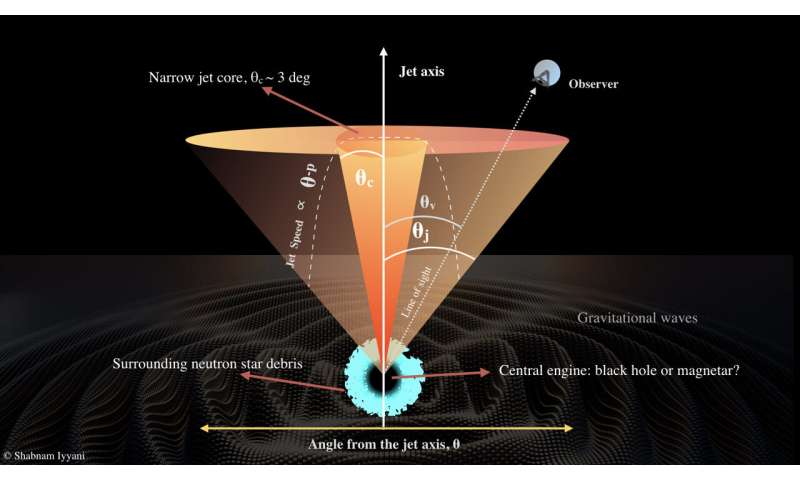Deciphering the binary compact object mergers through gamma-ray astronomy

During the height of the cold war in 1967, the Vela military satellites of the United States observed mysterious flashes of gamma rays. Due to the lack of information regarding their origin, the discovery of these events was kept confidential. Eventually, in 1973, the discovery was made public when it was determined to be originating from the sky.
These extremely intense flashes of energy observed in the sky are known as the gamma-ray bursts (GRBs), which are observed at an average rate of one event per day by gamma-ray space observatories. Typically in a single event, a gamma-ray burst releases about 1053 ergs of energy in a few seconds, which is about the same energy released by our sun in its entire lifetime (10 billion years). These explosions happen at faraway distances in our cosmos, and the observed gamma rays have thus traveled several million to billion years to reach us. These astronomical events are the key to our understanding of the complex but ordered universe.
Based on their duration, the GRBs are classified into two main types: long and short GRBs. These events originate from two different sources. Long GRBs are produced during the death of extremely massive stars (those several tens of times more massive than our sun, e.g, Wolf -Rayet stars) when the core of the star collapses to form a compact object like a black hole or a neutron star. On the other hand, short GRBs (sGRBs) are produced via the merger of compact objects like those of binary neutron stars or a neutron star with a black hole. The central engine subsequently formed produces the violent gamma-ray emission; however, the source has remained elusive. They are popularly believed to be either a black hole or a magnetar (fast-rotating, magnetized neutron star). Currently, several international scientific collaborations are actively investigating these phenomena through satellite-based space observatories.
Dawn of multi-messenger era
The progenitor of sGRBs is also the primary source of strong gravitational waves. The concurrent detection of gravitational waves (GW170817A) from the short GRB 170817A marked the beginning of the era of multi-messenger astronomy. Currently, sGRB is the only astronomical event that has been successfully observed across multiple messengers such as gravitational and electromagnetic waves.
A systematic study
In our recent work, we performed an extensive study to characterize the sGRBs and their origin. As the compact objects come closer to each other, they tidally disrupt the neutron star matter. Regardless of the kind of central compact object that is formed, eventually, it starts to accrete the surrounding matter and produces highly collimated jets traveling at speeds close to the speed of light. As the jet pierces through the surrounding dense matter, some of its energy is lost. Thus, the jet can acquire different speeds at different angles away from its axis and this has been shown to be the case by several theoretical hydrodynamic simulations. These jets can also be oriented in various directions to the observer in the case of different sGRBs. Thus, depending on the different structural properties of the jet and its orientations, the observer can see the gamma-ray radiation in different forms.
As the jet accelerates and expands, the density of the jet decreases. Subsequently, at some point, the light gets decoupled from the matter present in the jet and escapes to the observer. This deepest region in the jet from where any emission can be observed is referred to as the photosphere. Several studies have shown that most of the sGRB emissions tend to be produced from the jet photosphere. In this work, we have analyzed a sample of 39 different sGRB emissions using the jet photosphere model and have assessed the plausible jet orientations and also the structure and opening angles of the jets. We find that the sGRB jets possess a very narrow core region ~ 3 degrees in size where the largest jet speed is (Figure 1). We also find that nearly 43% of the sample possess the jet core to be pointed away from the observer.
Future vista
Knowing the opening angles of the sGRB jets are crucial in assessing the rate of events that can be coincidentally detected by both gravitational-wave detectors like LIGO, VIRGO, KAGRA and gamma-ray space observatories such as Fermi, Swift, AstroSat, INTEGRAL etc. In this study, we predict that nearly 1.8–26 /Gpc³/yr¹ bright sGRB gamma-ray events with their gravitational waves can be detected simultaneously considering the LIGO detector's current sensitivity. In addition, the viability of such complex jet photosphere model interpretations to the observed sGRB data allows us to speculate that the remnant of the merger of the binary neutron stars may be a black hole rather than a magnetar. In the era of multi-messenger astronomy, these underlying enigmas can be resolved using future observations.
This story is part of Science X Dialog, where researchers can report findings from their published research articles. Visit this page for information about ScienceX Dialog and how to participate.
More information:
Shabnam Iyyani et al. Study of prompt gamma ray emission of short gamma ray bursts using multi-color blackbody: a clue to the viewing angle, The Astrophysical Journal Supplement Series (2021). DOI: doi.org/10.3847/1538-4365/ac082f
Bio: Iyyani is currently working as INSPIRE Faculty Fellow under the Department of Science and Technology, India, fellowship. Her research expertise is in high energy astrophysics focussing on gamma-ray burst observations and physics. She has been working on this topic for the last 10 years. She completed her doctorate in 2015 from Stockholm University, Sweden, and has nearly 6 years of postdoctoral experience.